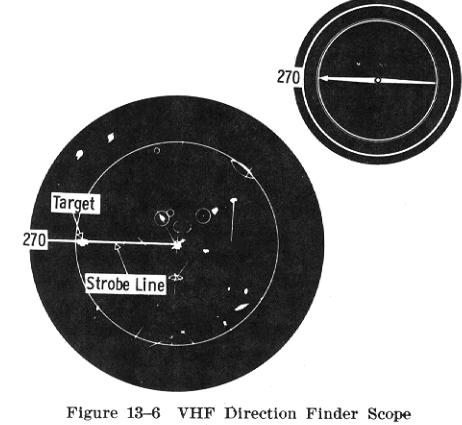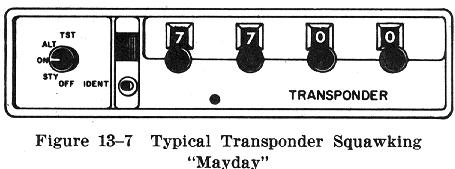Use of DF or Radar Services
Use of DF or Radar Services
While radio navigation aids can be very useful in following
a specific course, they do add to the pilot's workload, both mentally and
manually, particularly under dire circumstances. The pilot must divide
attention between control of the airplane and the operation of the navigation
equipment. Under the emergency conditions of flying the airplane by reference
to flight instruments, this is often a difficult task for experienced pilots.
However, there is another option available to pilots of
airplanes with or without radio navigation equipment if they have VHF radio
communications capability. All pilots should be aware of the VHF Direction
Finding (DF) and Radar service available all over the U.S., either through
civil or military radio facilities. This service permits a control tower,
FSS, or radar facility to give the pilot a heading to fly to reach a nearby
airport or to an area of good weather. In this way, the pilot need only
communicate and follow instructions while giving almost full attention
to flying the airplane.
To obtain assistance by radio and apply it effectively,
some preparation and training is necessary. All pilots should become familiar
with the appropriate emergency procedures and practice them when the situation
permits. The actual use of designated emergency radio frequencies for training
exercises is not permitted, but FAA facilities are often able to provide
practice orientation and radar guidance procedures using their regular
communications frequencies. In any case, the pilot must inform the ground
station when the request is only for practice purposes.
When a pilot is in doubt about the airplane's position,
or feels apprehensive about the safety of the flight, there should be no
hesitation to ask for help. That is the first means of declaring an emergency
- use the radio transmitter and ask for help. If in actual distress, and
help is needed immediately, the pilot should transmit the word MAYDAY several
times before transmitting the emergency message. This will get immediate
attention from all who hear.
Emergency messages may be transmitted on any radio frequency;
however, there is a frequency especially designated for such messages.
The designated emergency VHF frequency is 121.5 MHz and is available on
most radios installed in general aviation type airplanes. This is usually
the best frequency on which to transmit and receive because almost all
direction finding (DF) stations, radar facilities, and Flight Service Stations
monitor this frequency. Regardless of which type of facility is contacted,
that facility can help, even if only by alerting other facilities to the
emergency.
Since frequent communications may be necessary when using
this service, it is recommended that the microphone be continually held
in the hand. This will eliminate the need to take the eyes away from the
flight instruments every time the microphone is removed from or replaced
in its receptacle. After some practice, loosely holding the "mike" in one
hand should not create any difficulty in using the flight controls. It
is important though, that the "mike" button not be depressed accidentally,
which would block the frequency and prevent the reception of further assistance.
The initial request for assistance can be made on the regular communications
frequency of the facility, or on the emergency frequency 121.5 MHz. Regardless
of which frequency is used, it is essential that the pilot not change frequency
unless instructed to do so by the operator or unless absolutely necessary.
A direction finding (DF) station is a ground based receiver
capable of indicating the bearing from its antenna to the transmitting
airplane. There are HF, VHF, and UHF direction finding stations. However,
only VHF stations are discussed in this handbook, since this is the type
of radio equipment most likely to be in the airplanes flown by the average
general aviation pilot.
 |
If a pilot is unable to establish communication with a VHF/DF facility,
or if there is doubt about whether this service is available at a particular
station, the service may be obtained by calling any Flight Service Station
or control tower. The request then will be relayed immediately to the appropriate
DF facility. The pilot must remember, though, that VHF transmissions follow
line of sight; therefore, the higher the altitude, the better the chance
of obtaining this service. Depending on terrain conditions and altitude,
DF service is effective up to a radius of 100 miles.
The VHF/DF operator on the ground can note the airplane's bearing from
the facility by looking at a scope, quite similar to a radar scope. Each
time the pilot transmits, it shows up on the scope as a line radiating
out from the center (Fig. 13-6). From this the operator reads the course
the pilot should fly (with zero wind conditions) to reach the facility.
The pilot need not be concerned about wind drift since subsequent heading
instructions will consider the position to which the airplane has drifted
and a new course plotted. |
When DF services are requested by the pilot, the operator
will ask if the airplane is in VFR or IFR weather conditions, the amount
of fuel remaining, the altitude, and the heading. Also, the operator should
be informed whether the pilot is instrument rated. If the airplane is in
IFR weather conditions, the pilot will be informed of the minimum safe
altitude and the current local altimeter setting will be provided. The
pilot will then be instructed to transmit (by keying or voice) for 10 seconds.
To get a good indication on the scope, two continuous transmissions
of approximately 10 seconds each from the airplane are required. The volume
of the transmission should remain as nearly constant as possible. This
can be done by depressing the "mike" key for 10 seconds or by making a
voice transmission, "Aaaah," followed by the airplane's call sign and the
word "Over."
When the airplane's bearing has been determined, the DF
operator will specify the direction to turn and the magnetic heading to
be flown. (i.e., "TURN LEFT, HEADING ZERO ONE ZERO, FOR DF GUIDANCE TO
ARDMORE AIRPORT, REPORT AIRPORT IN SIGHT.") The number of times the transmissions
must be made will vary, depending on frequency congestion, distance, and
wind.
Radar equipped ATC facilities also provide assistance and
navigation service, provided the airplane has appropriate communications
equipment, is within radar coverage, and can be radar identified.
Primary radar relies on a signal being transmitted from
the radar antenna site and for this signal to be reflected or "bounced
back" from an airplane. This reflected signal is then automatically displayed
as a "target" or blip on the controller's radarscope. For identification
purposes, the pilot may be asked to turn the airplane in a certain direction
to a specific heading. If the airplane is transponder equipped, this identifying
turn is not necessary (Fig. 13-7).

A transponder is an airborne radar beacon transmitter/receiver
which automatically receives the signals from the ground based radar and
selectively replies with a specific code. These replies are independent
of and much stronger than the primary radar return and are displayed uniquely
on the radarscope. Thus, by having the pilot set the transponder to a certain
code, the radar controller can identify the airplane immediately. After
the controller positively identifies the airplane on the radarscope, the
pilot will be notified of the airplane's position and will then be given
a heading to an airport or other specific point in the radius of coverage
of the radar station.
The procedures used in providing radar navigational guidance
to pilots are very similar to those used for DF service. There are, however,
certain terms in the use of transponders which the pilot must understand.
When instructed to "Squawk" a certain code (number), the pilot should first
ensure that the transponder is set to the specified 4 digit number and
turned ON (not standby). If told to "Ident," the pilot should press the
button marked as such on the transponder. When told to "Squawk MAYDAY"
(the emergency position), the transponder should be set to 7700. The term
"Vector" simply means the heading to fly to reach a certain location.
Pilots should understand clearly that authorization to
proceed in accordance with such radar navigational assistance does not
constitute authorization for the pilot to violate Federal Aviation Regulations.
The controller must be informed whether the pilot is instrument rated and
whether the airplane is equipped for instrument flight.
To avoid possible hazards resulting from being vectored
into IFR conditions, a VFR pilot in difficulty should keep the controller
advised of the weather conditions in which the airplane is operating and
along the course ahead.
If the airplane has already encountered IFR conditions,
the controller will inform the pilot of the minimum safe altitude. If the
airplane is below the minimum safe altitude and sufficiently accurate position
information has been received or radar identification is established, a
heading or VOR radial on which to climb to reach the minimum safe altitude
will be furnished.

